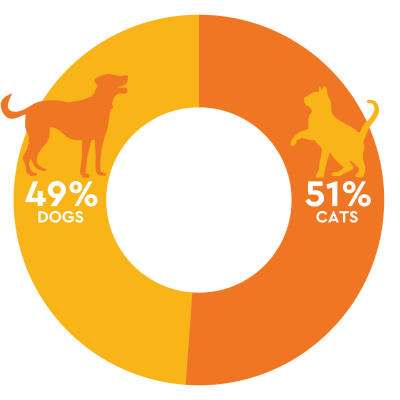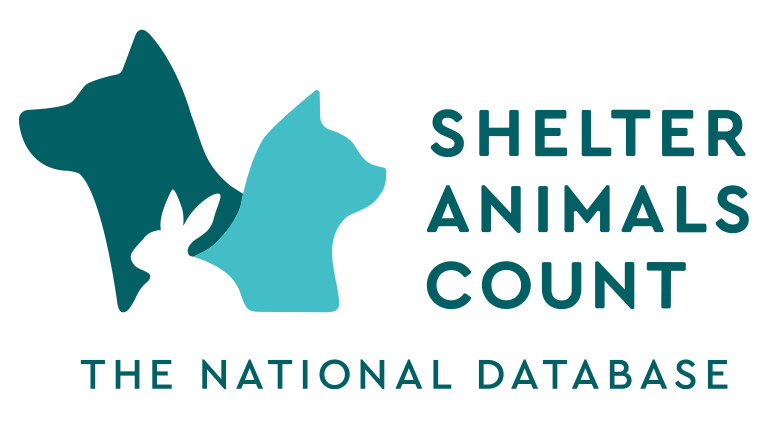2023 Statistics
- Home
- Explore the Data
- 2023 Statistics
In 2023, Shelter Animals Count estimates
6.5 million
cats and dogs entered shelters and rescues across America.

3.3 million cats

3.2 million dogs

This marks a 0.2% increase from 2022, a 4.0% increase from 2021, and 3.2% decrease from 2019.
Community intakes in 2023 remained fairly consistent with 2022, but are still 3% lower than 2019 — accounting for a reduction in roughly 214,000 animals entering organizations compared to pre-pandemic times. Community intakes remained evenly split between dogs and cats in 2023. In addition to animals entering organizations through their community, 1.5 million animals were transferred between organizations in 2023, marking an 4% decrease since 2022.
Of the animals in shelters and rescues in 2023,
4.8 million
were adopted into loving homes.

2.6 million
cats
2.2 million
dogs
Combined species adoption rates have increased over the years from 56% of intakes in 2019 to 61% in 2023.
109,000 more dogs were adopted in 2023 than in 2022, however the total number of dogs adopted in 2023 is still nearly 108,000 fewer (-5%) than in 2019.
34,000 more cats were adopted compared to 2022, while 319,000 more cats were adopted compared to 2019. The percentage of intakes that resulted in an adoption has increased from 59% in 2019 to 65% in 2023.
6.8 million
animals received a definitive outcome



Live Outcomes
return-to-field, etc.)
Non-live Outcomes
died in care, etc.)
More animals waiting for an outcome compared to 2022
Live outcomes are up by 166,000 animals compared to 2022, and up by 75,000 compared to 2019.
*Definitive outcomes are outcomes that remove the animal from the animal sheltering system (adoption, euthanasia, etc.) as opposed to outcomes that keep the animal in the animal sheltering system (foster, transfer, etc.)
690,000
total animals were euthanized in 2023.

330,000
cats euthanized
360,000
dogs euthanized
Non-live outcomes increased by 15% (112,000 animals) compared to
2022, but are still 16% lower than 2019 (156,000 animals).
Cats are also witnessing an uptick in non-live outcomes, albeit at a slower rate. There was an 8% increase (34,000 more cats) compared to 2022 and a 3% increase (+15,000 cats) compared to 2021. However, the data shows a positive shift as 31% fewer cats (-198,000 cats) experienced non-live outcomes in 2023 compared to 2019. Died in care rates for cats have remained relatively flat since 2021.
177,000
additional dogs and cats were in the animal sheltering system nationwide compared to the same time in 2022.
900,000 more animals have entered and lingered in our nation’s shelters since January 2021, resulting in an ongoing capacity crisis.
There are
14,429
animal-sheltering organizations in America.
The majority (85%) of community intakes occur in shelters, with 15% coming from rescues.
RESCUES
SHELTERS
Shelters With and Without Government Contracts
Total Animal Sheltering Organizations by State

Dig Into Historical Data with New Dashboard
There is currently no other estimate that includes all organization types and sizes for national animal welfare data. Understanding the number of animals entering and leaving the animal welfare system allows for more and better support of organizations providing services for these animals.
These totals are estimates based on all reported data to Shelter Animals Count since January 2016. It is best used as national totals. As more data is submitted and more research is conducted on what factors impact intakes/outcomes at the organization-level, these estimates will be adjusted. The estimates are rounded to the nearest 1,000 to allow for simplicity in communication.
The dataset contains intakes and outcomes for dogs and cats, reported by over 6,000 organizations across the United States and U.S. territories. Data is recorded monthly and includes January 2016-December 2023.
Organizations self-identify their organization type. Shelters include organizations with a physical building location such as government animal services, shelters/rescues with a government contract and shelters without a government contract. Rescues include organizations without a physical building and that rely on fosters for operation.
Monthly data is submitted voluntarily and therefore the number of organizations reporting each month varies. To eliminate the influence of this variation, the average and median number of monthly intakes over time was reviewed, allowing us to see clear seasonal patterns and medians were determined as the best option for determining national numbers.
Monthly medians were determined for each individual organization type and species (dog and cat). Those monthly medians were then applied to the total number of shelters and rescues included in the Complete Organization List created in partnership with Adopt A Pet. This includes 4,915 shelters (government animal services, shelters/rescues with a government contract, private shelters without a government contract) and 9,515 rescues (rescues without a government contract). Rescues are more likely to be focused on either cats or dogs, so based on Adopt A Pet’s ratio of how many rescues adopt out cats and how many adopt out dogs, that number of rescue organizations was applied.
The model for national intakes is based on community intakes (e.g. strays, owner surrenders, born in care, seized, etc). Transfer numbers are not included as those would result in double-counting an animal before a “final” outcome such as adoption. Organizations identified as foster-based rescues are primary transfer partners for government funded and private organizations. We assume that animals have an initial community intake and therefore do not count their transfer as an additional intake.
Similarly, national outcomes do not include transfers out as that is not a “final” outcome for the animal.
There is currently no research that provides associations between any demographic data, human population or external data to intakes or outcomes. Many elements could impact intakes for an organization that are both within the organization’s control, such as managed or selective intake or outcome protocols, and outside of the organization’s control such as economic changes or population density. Without research to confirm how these factors impact intakes and outcomes, applying them to the model would be arbitrary.

